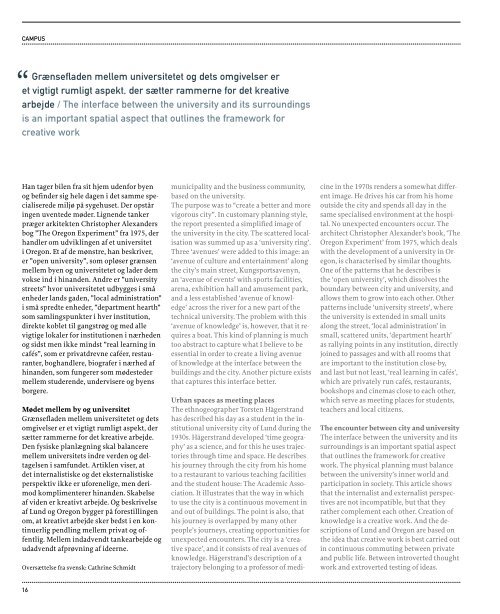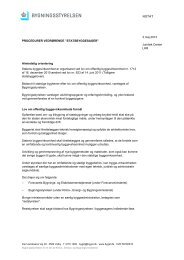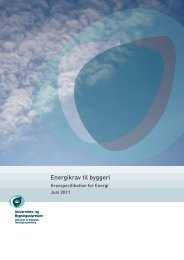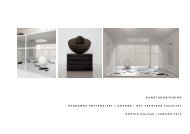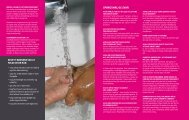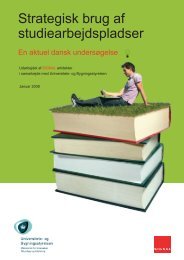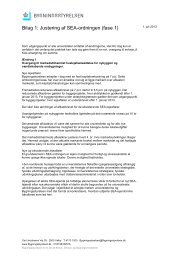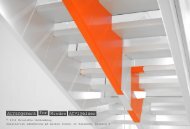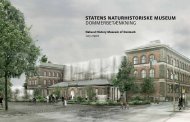Campus og studiemiljø - Bygningsstyrelsen
Campus og studiemiljø - Bygningsstyrelsen
Campus og studiemiljø - Bygningsstyrelsen
You also want an ePaper? Increase the reach of your titles
YUMPU automatically turns print PDFs into web optimized ePapers that Google loves.
<strong>Campus</strong><br />
“<br />
grænsefladen mellem universitetet <strong>og</strong> dets omgivelser er<br />
et vigtigt rumligt aspekt, der sætter rammerne for det kreative<br />
arbejde / the interface between the university and its surroundings<br />
is an important spatial aspect that outlines the framework for<br />
creative work<br />
Han tager bilen fra sit hjem udenfor byen<br />
<strong>og</strong> befinder sig hele dagen i det samme specialiserede<br />
miljø på sygehuset. Der opstår<br />
ingen uventede møder. Lignende tanker<br />
præger arkitekten Christopher Alexanders<br />
b<strong>og</strong> ”The Oregon Experiment” fra 1975, der<br />
handler om udviklingen af et universitet<br />
i Oregon. Et af de mønstre, han beskriver,<br />
er ”open university”, som opløser grænsen<br />
mellem byen <strong>og</strong> universitetet <strong>og</strong> lader dem<br />
vokse ind i hinanden. Andre er ”university<br />
streets” hvor universitetet udbygges i små<br />
enheder lands gaden, ”local administration”<br />
i små spredte enheder, ”department hearth”<br />
som samlingspunkter i hver institution,<br />
direkte koblet til gangstrøg <strong>og</strong> med alle<br />
vigtige lokaler for institutionen i nærheden<br />
<strong>og</strong> sidst men ikke mindst ”real learning in<br />
cafés”, som er privatdrevne caféer, restauranter,<br />
b<strong>og</strong>handlere, bi<strong>og</strong>rafer i nærhed af<br />
hinanden, som fungerer som mødesteder<br />
mellem studerende, undervisere <strong>og</strong> byens<br />
borgere.<br />
Mødet mellem by <strong>og</strong> universitet<br />
Grænsefladen mellem universitetet <strong>og</strong> dets<br />
omgivelser er et vigtigt rumligt aspekt, der<br />
sætter rammerne for det kreative arbejde.<br />
Den fysiske planlægning skal balancere<br />
mellem universitets indre verden <strong>og</strong> deltagelsen<br />
i samfundet. Artiklen viser, at<br />
det internalistiske <strong>og</strong> det eksternalistiske<br />
perspektiv ikke er uforenelige, men derimod<br />
komplimenterer hinanden. Skabelse<br />
af viden er kreativt arbejde. Og beskrivelse<br />
af Lund <strong>og</strong> Oregon bygger på forestillingen<br />
om, at kreativt arbejde sker bedst i en kontinuerlig<br />
pendling mellem privat <strong>og</strong> offentlig.<br />
Mellem indadvendt tankearbejde <strong>og</strong><br />
udadvendt afprøvning af ideerne.<br />
Oversættelse fra svensk: Cathrine Schmidt<br />
16<br />
municipality and the business community,<br />
based on the university.<br />
The purpose was to “create a better and more<br />
vigorous city”. In customary planning style,<br />
the report presented a simplified image of<br />
the university in the city. The scattered localisation<br />
was summed up as a ‘university ring’.<br />
Three ‘avenues’ were added to this image: an<br />
‘avenue of culture and entertainment’ along<br />
the city’s main street, Kungsportsavenyn,<br />
an ‘avenue of events’ with sports facilities,<br />
arena, exhibition hall and amusement park,<br />
and a less established ‘avenue of knowledge’<br />
across the river for a new part of the<br />
technical university. The problem with this<br />
‘avenue of knowledge’ is, however, that it requires<br />
a boat. This kind of planning is much<br />
too abstract to capture what I believe to be<br />
essential in order to create a living avenue<br />
of knowledge at the interface between the<br />
buildings and the city. Another picture exists<br />
that captures this interface better.<br />
urban spaces as meeting places<br />
The ethn<strong>og</strong>e<strong>og</strong>rapher Torsten Hägerstrand<br />
has described his day as a student in the institutional<br />
university city of Lund during the<br />
1930s. Hägerstrand developed ‘time ge<strong>og</strong>raphy’<br />
as a science, and for this he uses trajectories<br />
through time and space. He describes<br />
his journey through the city from his home<br />
to a restaurant to various teaching facilities<br />
and the student house: The Academic Association.<br />
It illustrates that the way in which<br />
to use the city is a continuous movement in<br />
and out of buildings. The point is also, that<br />
his journey is overlapped by many other<br />
people’s journeys, creating opportunities for<br />
unexpected encounters. The city is a ‘creative<br />
space’, and it consists of real avenues of<br />
knowledge. Hägerstrand’s description of a<br />
trajectory belonging to a professor of medi-<br />
cine in the 1970s renders a somewhat different<br />
image. He drives his car from his home<br />
outside the city and spends all day in the<br />
same specialised environment at the hospital.<br />
No unexpected encounters occur. The<br />
architect Christopher Alexander’s book, ‘The<br />
Oregon Experiment’ from 1975, which deals<br />
with the development of a university in Oregon,<br />
is characterised by similar thoughts.<br />
One of the patterns that he describes is<br />
the ‘open university’, which dissolves the<br />
boundary between city and university, and<br />
allows them to grow into each other. Other<br />
patterns include ‘university streets’, where<br />
the university is extended in small units<br />
along the street, ‘local administration’ in<br />
small, scattered units, ‘department hearth’<br />
as rallying points in any institution, directly<br />
joined to passages and with all rooms that<br />
are important to the institution close-by,<br />
and last but not least, ‘real learning in cafés’,<br />
which are privately run cafés, restaurants,<br />
bookshops and cinemas close to each other,<br />
which serve as meeting places for students,<br />
teachers and local citizens.<br />
the encounter between city and university<br />
The interface between the university and its<br />
surroundings is an important spatial aspect<br />
that outlines the framework for creative<br />
work. The physical planning must balance<br />
between the university’s inner world and<br />
participation in society. This article shows<br />
that the internalist and externalist perspectives<br />
are not incompatible, but that they<br />
rather complement each other. Creation of<br />
knowledge is a creative work. And the descriptions<br />
of Lund and Oregon are based on<br />
the idea that creative work is best carried out<br />
in continuous commuting between private<br />
and public life. Between introverted thought<br />
work and extroverted testing of ideas.


